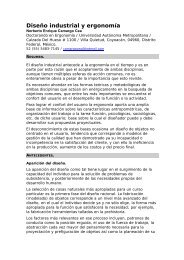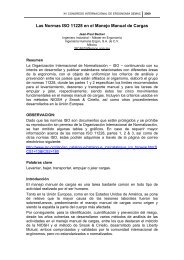ERGONOMÍA OCUPACIONAL - SOCIEDAD DE ERGONOMISTAS ...
ERGONOMÍA OCUPACIONAL - SOCIEDAD DE ERGONOMISTAS ...
ERGONOMÍA OCUPACIONAL - SOCIEDAD DE ERGONOMISTAS ...
Create successful ePaper yourself
Turn your PDF publications into a flip-book with our unique Google optimized e-Paper software.
Ergonomía Ocupacional. Investigaciones y Aplicaciones. Vol 3 2010<br />
2.3. Experimental Design Application: Fourth Stage – Experimentation.<br />
In the industry the resources are in general limited it is very probable that the number of<br />
experiments is limited to the available budget, in this case a design factorial finished and with only<br />
one experimental response can be used, nevertheless the principal effects can contain an error<br />
generated by the external noise (Montgomery, 2006). The principal disability of this method<br />
consists of the fact that is known that to certain number of factors this process is expensive.<br />
The methodology Taguchi usually guarantees less experimental tests and makes use of the big<br />
advantage of the orthogonal arrangements then to construct a reliable model to know the value of<br />
the average of the process with the following equation:<br />
ˆ = y + ( A − y)<br />
+ ( B − y)<br />
+ ... + ( N − y)<br />
(1)<br />
y k<br />
r<br />
s<br />
Where:<br />
yˆ = theoretical average of the process.<br />
y = real average of the process.<br />
A , B,...<br />
N Are the experimental factors.<br />
k , r,...<br />
s Are the levels of the experimental factors.<br />
In this way, the Monte Carlo method is used to simulate all possible iterations in a predictive<br />
model of values of the average. This means that in our methodology there will be randomized the<br />
order of the capture of information to only one reply and later to obtain the theoretical model of the<br />
average based on the contribution of the principal effects, with the equation (1) there will be<br />
generated all the possible values of the average making use of the Simulation Monte Carlo. In<br />
studies realized with regard to the MAPE of the theoretical model his value is usually 4 %<br />
(Fabiani, 2008).<br />
With regard to the person chosen for the experiment, the International Organization of the Work<br />
tells that the "average" worker does not exist in the reality, but based on the requests of the<br />
Sociedad de Ergonomistas de México, A.C. 82




